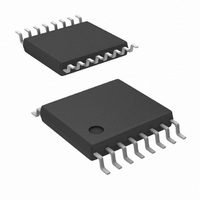ADC78H89CIMT/NOPB National Semiconductor, ADC78H89CIMT/NOPB Datasheet - Page 8

ADC78H89CIMT/NOPB
Manufacturer Part Number
ADC78H89CIMT/NOPB
Description
IC ADC 12BIT 500KSPS 7CH 16TSSOP
Manufacturer
National Semiconductor
Series
PowerWise®r
Datasheet
1.ADC78H89CIMTNOPB.pdf
(16 pages)
Specifications of ADC78H89CIMT/NOPB
Number Of Bits
12
Sampling Rate (per Second)
500k
Data Interface
DSP, MICROWIRE™, QSPI™, Serial, SPI™
Number Of Converters
1
Power Dissipation (max)
8.3mW
Voltage Supply Source
Analog and Digital
Operating Temperature
-40°C ~ 85°C
Mounting Type
Surface Mount
Package / Case
16-TSSOP (0.173", 4.40mm Width)
Number Of Elements
1
Resolution
12Bit
Architecture
SAR
Sample Rate
500KSPS
Input Polarity
Unipolar
Input Type
Voltage
Rated Input Volt
5.25V
Differential Input
No
Power Supply Requirement
Analog and Digital
Single Supply Voltage (typ)
3.3/5V
Single Supply Voltage (min)
2.7V
Single Supply Voltage (max)
5.25V
Dual Supply Voltage (typ)
Not RequiredV
Dual Supply Voltage (min)
Not RequiredV
Dual Supply Voltage (max)
Not RequiredV
Differential Linearity Error
±1LSB
Integral Nonlinearity Error
±1LSB
Operating Temp Range
-40C to 85C
Operating Temperature Classification
Industrial
Mounting
Surface Mount
Pin Count
16
Package Type
TSSOP
Input Signal Type
Single-Ended
Lead Free Status / RoHS Status
Lead free / RoHS Compliant
Other names
*ADC78H89CIMT
*ADC78H89CIMT/NOPB
ADC78H89CIMT
*ADC78H89CIMT/NOPB
ADC78H89CIMT
Available stocks
Company
Part Number
Manufacturer
Quantity
Price
Company:
Part Number:
ADC78H89CIMT/NOPB
Manufacturer:
TI
Quantity:
3 100
www.national.com
Specification Definitions
ACQUISITION TIME is the time required to acquire the input
voltage. That is, it is time required for the hold capacitor to
charge up to the input voltage.
APERTURE DELAY is the time between the fourth falling
SCLK edge of a conversion and the time when the input
signal is acquired or held for conversion.
CONVERSION TIME is the time required, after the input
voltage is acquired, for the ADC to convert the input voltage
to a digital word.
CROSSTALK is the coupling of energy from one channel
into the other channel, or the amount of signal energy from
one analog input that appears at the measured analog input.
DIFFERENTIAL NON-LINEARITY (DNL) is the measure of
the maximum deviation from the ideal step size of 1 LSB.
DUTY CYCLE is the ratio of the time that a repetitive digital
waveform is high to the total time of one period. The speci-
fication here refers to the SCLK.
EFFECTIVE NUMBER OF BITS (ENOB, or EFFECTIVE
BITS) is another method of specifying Signal-to-Noise and
Distortion or SINAD. ENOB is defined as (SINAD - 1.76) /
6.02 and says that the converter is equivalent to a perfect
ADC of this (ENOB) number of bits.
FULL POWER BANDWIDTH is a measure of the frequency
at which the reconstructed output fundamental drops 3 dB
below its low frequency value for a full scale input.
GAIN ERROR is the deviation of the last code transition
(111...110) to (111...111) from the ideal (V
after adjusting for offset error.
INTEGRAL NON-LINEARITY (INL) is a measure of the
deviation of each individual code from a line drawn from
negative full scale (
through positive full scale (
transition). The deviation of any given code from this straight
line is measured from the center of that code value.
INTERMODULATION DISTORTION (IMD) is the creation of
additional spectral components as a result of two sinusoidal
frequencies being applied to the ADC input at the same time.
It is defined as the ratio of the power in the both second
order (or all four third order) intermodulation products to the
1
⁄
2
LSB below the first code transition)
1
⁄
2
LSB above the last code
REF
- 1.5 LSB),
8
sum of the power in both of the original frequencies. IMD is
usually expressed in dBFS.
MISSING CODES are those output codes that will never
appear at the ADC outputs. The ADC78H89 is guaranteed
not to have any missing codes.
OFFSET ERROR is the deviation of the first code transition
(000...000) to (000...001) from the ideal (i.e. GND + 0.5
LSB).
SIGNAL TO NOISE RATIO (SNR) is the ratio, expressed in
dB, of the rms value of the input signal to the rms value of the
sum of all other spectral components below one-half the
sampling frequency, not including harmonics or d.c.
SIGNAL TO NOISE PLUS DISTORTION (S/N+D or SINAD)
Is the ratio, expressed in dB, of the rms value of the input
signal to the rms value of all of the other spectral compo-
nents below half the clock frequency, including harmonics
but excluding d.c.
SPURIOUS FREE DYNAMIC RANGE (SFDR) is the differ-
ence, expressed in dB, between the rms values of the input
signal and the peak spurious signal, where a spurious signal
is any signal present in the output spectrum that is not
present at the input.
TOTAL HARMONIC DISTORTION (THD) is the ratio, ex-
pressed in dB, expressed in dB or dBc, of the rms total of the
first five harmonic components at the output to the rms level
of the input signal frequency as seen at the output. THD is
calculated as
where A
output and A
harmonic frequencies.
THROUGHPUT TIME is the minimum time required between
the start of two successive conversion. It is the acquisition
time plus the conversion time. In the case of the ADC78H89,
this is 16 SCLK periods.
f1
is the RMS power of the input frequency at the
f2
through A
f6
are the RMS power in the first 5











